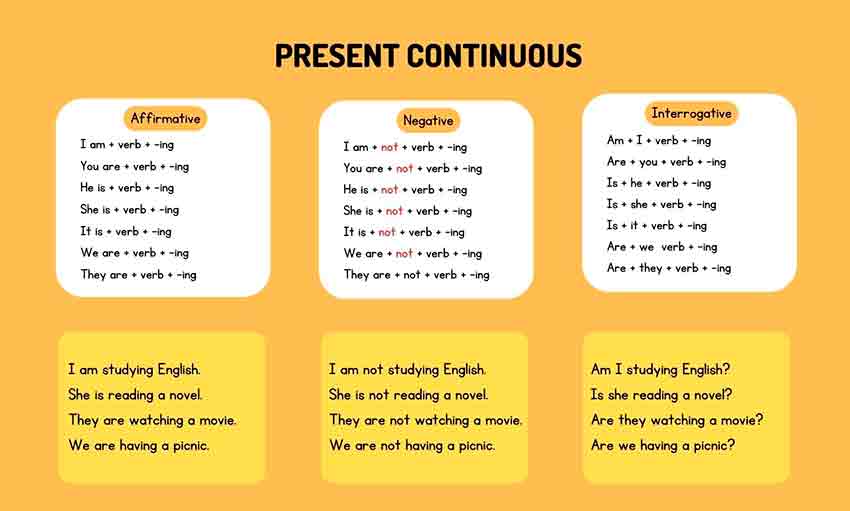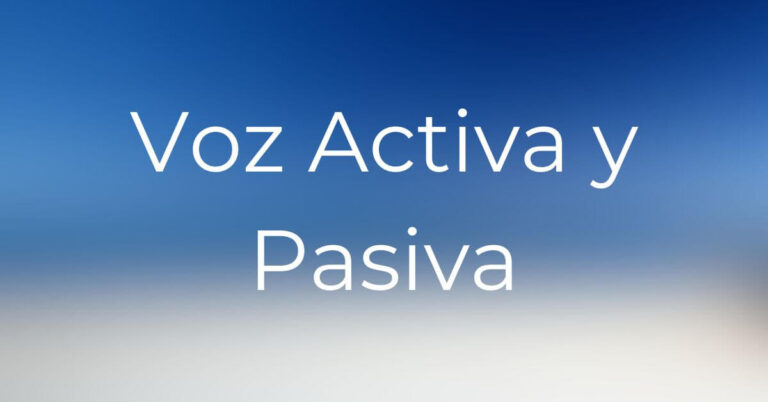El Presente Continuo en Inglés
El Presente Continuo en Inglés
El Presente Continuo en Inglés es un tiempo verbal muy útil en el idioma inglés que permite a los hablantes describir acciones que están ocurriendo en el momento presente de manera precisa y detallada.
Table of Contents
ToggleCuando usar el Presente Continuo
El Presente Continuo se puede utilizar en los siguientes momentos:
Para describir acciones que están ocurriendo en el momento presente:
Ejemplo:
“I am writing a blog post right now.” (Estoy escribiendo una entrada de blog en este momento).
Para describir acciones inusuales o imprevistas que están ocurriendo en el momento presente:
Ejemplo:
“It is raining heavily today.” (Está lloviendo fuertemente hoy).
Para describir acciones planificadas o programadas para el futuro que ya están en curso:
Ejemplo:
“I am preparing for my exam next week.” (Estoy preparándome para mi examen la próxima semana).
Para describir acciones en curso y continuarán en el futuro:
Ejemplo:
“She is studying to become a doctor.” (Ella está estudiando para convertirse en una doctora).
Para describir una acción o evento en curso en comparación con una acción o evento más permanente o duradero:
Ejemplo:
“I am living in New York while my family is in Spain.” (Estoy viviendo en Nueva York mientras que mi familia está en España).
Como Formar Frases En Presente Continuo?
La fórmula para el Presente Continuo en inglés es:
Sujeto + verbo “to be” (ser/estar en presente) + verbo en gerundio (-ing).
I + am + working
A continuación, se presentan las formas del Presente Continuo para cada uno de los pronombres en inglés:
- I am (yo estoy) + verbo en gerundio
- You are (tú eres o tú estás) + verbo en gerundio
- He/She/It is (él/ella/ello es o él/ella/ello está) + verbo en gerundio
- We are (nosotros somos o nosotros estamos) + verbo en gerundio
- They are (ellos/ellas son o ellos/ellas están) + verbo en gerundio
(verbo en gerundio es el verbo en la forma base con -ing, como eat+ing, work+ing, play+ing etc)
(ej: eating “comiendo”, working “trabajando”, drinking “tomando”, playing “jugando”, sleeping “durmiendo”)

Forma Afirmativa Del Presente Continuo En Ingles
Las formas positivas del Presente Continuo se forman con el verbo “to be” en presente y el verbo principal en gerundio (-ing).
SUJETO + TO BE + VERBO + ING
Por ejemplo: “I am eating breakfast.” (Estoy comiendo desayuno).
Ejemplos en forma afirmativa o positiva
- I am reading a book. (Estoy leyendo un libro)
- She is playing the piano. (Ella está tocando el piano)
- They are having a party tonight. (Ellos están teniendo una fiesta esta noche)
- He is studying for his exam. (El está estudiando para su examen)
- We are planning a trip to Europe. (Estamos planeando un viaje a Europa)
- The children are playing in the park. (Los niños están jugando en el parque)
- The sun is shining brightly. (El sol está brillando intensamente)
- The flowers are blooming in the garden. (Las flores están floreciendo en el jardín)
- I am learning a new language. (Estoy aprendiendo un nuevo idioma)
- She is cooking dinner for us. (Ella está cocinando la cena para nosotros)
- They are practicing for their performance. (Ellos están practicando para su presentación)
- The dog is chasing its tail. (El perro está persiguiendo su cola)
- The train is arriving at the station. (El tren está llegando a la estación)
- I am writing an email to my friend. (Estoy escribiendo un correo electrónico a mi amigo)
- She is taking a nap on the couch. (Ella está tomando una siesta en el sofá)
Forma Negativa Del Presente Continuo En Ingles
Las formas negativas del Presente Continuo se forman con el verbo “to be” en presente y la palabra negativa “not” antes del verbo principal en gerundio.
SUJETO + TO BE + NOT + VERBO + ING
Por ejemplo: “I am not eating breakfast.” (No estoy comiendo desayuno).
Ejemplos Adicionales
- I am not reading a book. (No estoy leyendo un libro)
- She is not playing the piano. (Ella no está tocando el piano)
- They are not having a party tonight. (Ellos no están teniendo una fiesta esta noche)
- He is not studying for his exam. (El no está estudiando para su examen)
- We are not planning a trip to Europe. (No estamos planeando un viaje a Europa)
- The children are not playing in the park. (Los niños no están jugando en el parque)
- The sun is not shining brightly. (El sol no está brillando intensamente)
- The flowers are not blooming in the garden. (Las flores no están floreciendo en el jardín)
- I am not learning a new language. (No estoy aprendiendo un nuevo idioma)
- She is not cooking dinner for us. (Ella no está cocinando la cena para nosotros)
- They are not practicing for their performance. (Ellos no están practicando para su presentación)
- The dog is not chasing its tail. (El perro no está persiguiendo su cola)
- The train is not arriving at the station. (El tren no está llegando a la estación)
- I am not writing an email to my friend. (No estoy escribiendo un correo electrónico a mi amigo)
- She is not taking a nap on the couch. (Ella no está tomando una siesta en el sofá)
Forma interrogativa Del Presente Continuo En Ingles
Las formas interrogativas del Presente Continuo se forman con el verbo “to be” en presente seguido del sujeto y luego del verbo principal en gerundio.
TO BE + SUJETO + VERBO + ING
Por ejemplo: “Are you eating breakfast?” (¿Estás comiendo desayuno?).
Ejemplos adicionales
- Am I reading a book? (¿Estoy leyendo un libro?)
- Is she playing the piano? (¿Está ella tocando el piano?)
- Are they having a party tonight? (¿Están ellos teniendo una fiesta esta noche?)
- Is he studying for his exam? (¿Está él estudiando para su examen?)
- Are we planning a trip to Europe? (¿Estamos planeando un viaje a Europa?)
- Are the children playing in the park? (¿Están los niños jugando en el parque?)
- Is the sun shining brightly? (¿Está el sol brillando intensamente?)
- Are the flowers blooming in the garden? (¿Están las flores floreciendo en el jardín?)
- Am I learning a new language? (¿Estoy aprendiendo un nuevo idioma?)
- Is she cooking dinner for us? (¿Está ella cocinando la cena para nosotros?)
- Are they practicing for their performance? (¿Están ellos practicando para su presentación?)
- Is the dog chasing its tail? (¿Está el perro persiguiendo su cola?)
- Is the train arriving at the station? (¿Está llegando el tren a la estación?)
- Am I writing an email to my friend? (¿Estoy escribiendo un correo electrónico a mi amigo?)
- Is she taking a nap on the couch? (¿Está ella tomando una siesta en el sofá?)
Respuestas a Las Preguntas En Presente Continuo
Las respuestas a las preguntas en Presente Continuo pueden ser breves o extensas.
Pregunta
Is she playing the piano? (¿Está ella tocando el piano?)
Respuestas cortas:
Yes, she is (si, ella es / ella está)
No, she is not (isn’t) (No, ella no es / ella no está)
Rspuestas extensas:
Yes, she is playing the piano (si, ella esta tocando el piano)
No, she is not playing the piano (No, ella no esta tocando el piano)
Conclusión
En conclusión, el Presente Continuo es un tiempo verbal importante en el idioma inglés que permite a los hablantes describir situaciones y acciones que están sucediendo en el momento presente. Es importante conocer las formas positivas, negativas e interrogativas del Presente Continuo para poder utilizarlo de manera efectiva en las conversaciones y para comprender mejor el idioma. Con práctica y estudio, los hablantes de español pueden desarrollar su comprensión y habilidad en el uso del Presente Continuo en inglés.








Thanks for sharing. I read many of your blog posts, cool, your blog is very good.
Thank you so much for taking the time to read my blog posts and for your kind words. I’m thrilled to hear that you found my blog to be interesting and of high quality. Your positive feedback is greatly appreciated, and it inspires me to continue producing informative and engaging content. Thank you again for your support.
Your point of view caught my eye and was very interesting. Thanks. I have a question for you.
Thanks for sharing. I read many of your blog posts, cool, your blog is very good.
Your point of view caught my eye and was very interesting. Thanks. I have a question for you.